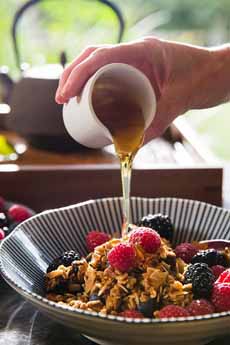
February 2005
Updated January 2009
|
 |
Honey Lovers’ Facts & Trivia
Page 2: The Honey Bee
This is Page 2 of a three-page article. Click on the black links below to visit other pages.
The Honey Bee
 |
Bees have been producing honey from flowering plants for 10 to 20 million years.
|
 |
Honey bees must tap two million flowers to make one pound of honey.
|
 |
A hive of bees flies 55,000 miles to make one pound of honey (more than the distance to the moon and back). A bee must fly the equivalent of three times around the globe to gather a single teaspoon of honey.
|
 |
A healthy colony of bees can produce 300 to 500 pounds of honey per year.
|
 |
A bee visits 50 to 100 flowers during one collection trip.
|
 |
Bees are not fast fliers; while their wings beat over 11,000 cycles per minute, their flight speed averages only 15 miles per hour. In comparison, a true fly in the genus Forcipomyia beats its wings over 62,000 cycles per minute. The Australian dragonfly Austrophlebia costalis has been clocked flying at a speed of 36 mph.
|
 |
Bees possess five eyes. The three ocelli are simple eyes that discern light intensity, while each of the two large compound eyes contains about 6,900 facets and is well suited for detecting movement. In fact, honeybees can perceive movements that are separated by 1/300th of a second. Humans can only sense movements separated by 1/50th of a second. Were a bee to enter a cinema, it would be able to differentiate each individual movie frame being projected.
|
| |
 |
Honeybees communicate with each other by “dancing.” Scout bees dance to alert the other bees to where nectar and pollen are located. The dance explains direction and distance relative to the sun. Bees also communicate with pheromones.
|
 |
Mathematically, honeycomb is the second strongest structure in the world after the pyramids.
|
 |
In addition to honey, honey bees produce beeswax and help pollinate agricultural crops, home gardens and wildlife habitats.
|
| |
 |
The honeybee is directly responsible for 80% to 85% of all vital pollination. This accounts for more than 2/3 of the food we eat (from almonds to peaches to scores of other crops that cannot self-pollinate effectively enough for commercial agriculture). Every year, migratory beekeepers are contracted all over the country to pollinate roughly 85% of all food crops.
|
| |
 |
Due to pestilence and pesticide misuse, it is estimated that fewer than 1% of bees in the United States are wild. The rest live in hives tended by beekeepers. An estimated 5% of beekeepers quit beekeeping annually due to the mite epidemic and import competition.
|
Continue To Page 3: Honey Production
Go To The Article Index Above
Trivia sources: ABC to XYZ of Bee Culture (the A.I. Root Company, 1990), National Honey Board.
Lifestyle Direct, Inc. Images are copyright of their respective owners.
|




